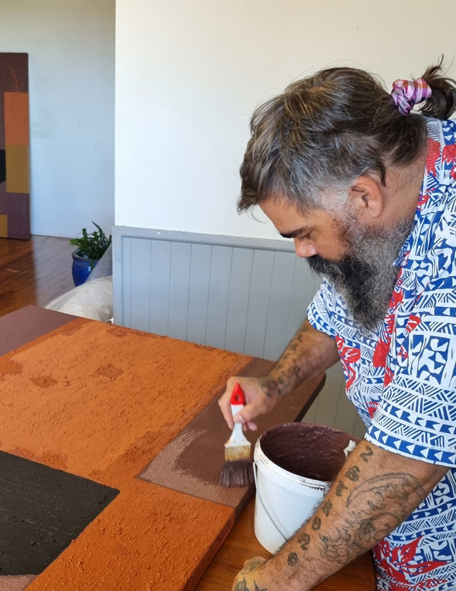By Kirra Livingstone
AT THE heart of Indigenous artist BJ Murphy’s first solo exhibition is the unyielding drive to represent his country through his art.
BJ is a Jinibara man and his exhibition, Mimburi Ninyangurra, translated to Continuous Flow of Dreaming, is a tribute to his country and the flow of knowledge it offers if you listen.
Exhibiting at Munnimbah-dja Gallery in Maleny until July 2 it is the culmination of years of lived experience in his country and a reflection of that gained knowledge.
But BJ says it wasn’t until 2012 that he first started to understand his wider family when he received a “big booklet” of information, written by his great great uncle.
He said it included nearly everything from their culture, from the country they grew up in and explained the importance of having Indigenous knowledge documented. “The way he documented that history, it gives you that little tease, or he puts you on that path with a specific sentence and normally you’ll find the ending or the answer whilst you’re out walking country,” BJ said.
“I always saw it as a way of activism on his behalf and… I think he knew the only real way to save our culture was to document as much as he could excluding stuff like sacred ceremony.
“That was his way of preserving it for the future and now it’s a time where people are starting to listen and…acknowledging it and moving forward together.
He added that he now felt safer to repatriate “because we have to relearn all our old languages and our old ways”.
He acknowledged the exhibition isn’t what people usually expect when they think of aboriginal art.

His main body of work, six framed paintings, is distinct for its seemingly structured straight lines and defined shapes.
The pieces represent bodies and depict the body paint from his tribe that would be word for ceremonies. The sourcing of materials was also a way for BJ to connect with country, sourcing the right ochres across many long days.
“They are done with Jinibara ochres from country, I’ve had to walk and find those specific colours and where they’re from,” BJ said.
“They are made with Jinibara country, although I’ve had to find that contemporary way and get it to stick to that canvas, rather than the skin. To me these paintings really are Jinibara.”
“Our iron bark charcoal, which is the black parts on the paintings, that’s actual iron bark charcoal that I’ve burnt and ground up.”
The exhibition also includes a sculptural installation of a Jinibara man, woman and child made from large branches.
To make the experience more immersive, there is chanting playing in the background which is another Jinibara family member welcoming chiefs onto the ground.
The exhibition is open from Thursday to Saturday until July 2.
